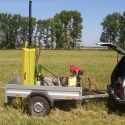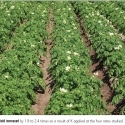08 Dec 2011
A Global Framework for Fertilizer BMPs
By T.W. Bruulsema, C. Witt, Fernando García, Shutian Li, T. Nagendra Rao, Fang Chen, and S. Ivanova
At the farm level, cropping systems are managed for multiple objectives. Best management practices are those that most closely attain those objectives. Management of fertilizer use falls within a larger agronomic context of cropping system management. A framework is helpful for describing how BMPs for fertilizer use fit in with those for the agronomic system. The goals of sustainable development, in the general sense, comprise equal emphasis on economic, social, and ecological aspects (Brundtland, 1987). Such development is essential to provide for the needs of current and future generations. At the farm level, however, it is difficult to relate specific crop management practices to these three general aspects. Four management objectives are applicable to the practical farm level of all cropping systems (Witt, 2003). These four objectives are productivity, profitability, cropping system sustainability, and a favorable biophysical and social environment (PPSE). They relate to each other as illustrated in Figure 1. Fertilizer use BMPs comprise an interlinked subset of crop management BMPs. For a fertilizer use practice to be considered “best”, it must harmonize with the other agronomic practices in providing an optimum combination of the four objectives, PPSE. It follows that the development, evaluation, and refinement of BMPs at the farm level must consider all four objectives, as must selection of indicators reflecting their combined impact at the regional, national, or global level. Appropriate indicators for use at different scales are further discussed below in the section on performance indicators.
Figure 1: Illustration of a global framework for BMPs for fertilizer use. Fertilizer use BMPs—applying the right nutrient source at the right rate, time, and place—integrate with agronomic BMPs selected to achieve crop management objectives of productivity, profitability, sustainability, and environmental health. A balanced complement of indicators is needed to reflect the influence of fertilizer BMPs on the four crop management objectives at the farm level, and on the economic, ecological, and social goals for sustainable development on the broader scale for regional public policies.
Cropping System Management Objectives
Productivity. For cropping systems, the primary measure of productivity is yield per unit area of cropland per unit of time. Productivity should be considered in terms of all resources, or production factors, involved. Several indicators describing production and input use efficiencies are probably required to properly evaluate productivity. Profitability. Profitability is determined by the difference between the value of the produce (gross benefit or revenue) and the cost of production. Its primary measure is net benefit per unit of cropland per unit of time. The profitability gain of a specific management practice is the increase in gross revenue it generates, less its marginal cost.
Sustainability. Sustainability—at the level of the cropping system—refers to the influence of time on the resources involved. A sustainable production system is one in which the quality (or efficiency) of the resources used does not diminish over time, so that “outputs do not decrease when inputs are not increased” (Monteith, 1990).
Environment (biophysical and social). Crop production systems have a wide range of effects on surrounding ecosystems through material losses to water and air. Specific effects can be limited to some extent by practices designed to optimize efficiency of resource use. Management choices at the farm level, when aggregated, also influence the social environment through demand for labor, working conditions, changes in ecosystem services, etc.
Fertilizer Management Objectives
Fertilizer use BMPs essentially support the four objectives identified for cropping systems management and can be aptly described as the selection of the right source for application at the right rate, time, and place (Roberts, 2007). Fertilizer source, rate, timing, and placement are interdependent, and are also interlinked with the set of agronomic management practices applied in the cropping system, as illustrated inFigure 1.
Scientific Principles
Specific scientific principles apply to crop and fertilizer use BMPs as a group and individually. These principles are both global and applicable at the practical farm management level. The application of these scientific principles may differ widely depending on the specific cropping system under consideration.
Specific principles relevant to each category of BMPs are listed below.
1) Crop Management
a) Seek practical measured validation.
b) Recognize and adapt to risks.
c) Define performance indicators.
d) Ensure two-way feedback between global and practical farm levels.
2) Fertilizer Management
a) Be consistent with understood process mechanisms.
b) Recognize interactions with other cropping system factors.
c) Recognize interactions among nutrient source, rate, time, and place.
d) Avoid detrimental effects on plant roots, leaves and seedlings.
e) Recognize effects on crop quality as well as yield.
f) Consider economics.
3) Source
a) Supply nutrients in plant-available forms.
b) Suit soil physical and chemical properties.
c) Recognize synergisms among nutrient elements and sources.
d) Recognize blend compatibility.
e) Recognize benefits and sensitivities to associated elements.
f) Control effects of non-nutritive elements.
4) Rate
a) Use adequate methods to assess soil nutrient supply.
b) Assess all indigenous nutrient sources available to the crop.
c) Assess crop demand for nutrients.
d) Predict fertilizer use efficiency.
e) Consider soil resource impacts.
f) Consider rate-specific economics.
5) Time
a) Assess timing of crop uptake.
b) Assess dynamics of soil nutrient supply.
c) Recognize timing of weather factors influencing nutrient loss.
d) Evaluate logistics of field operations.
6) Place
a) Recognize root-soil dynamics.
b) Manage spatial variability within fields and among farms.
c) Fit needs of tillage system.
d) Limit potential off-field transport of nutrients.
The number of scientific principles applicable to a given practical farming situation is considerable. Narrowing down to a set of BMPs appropriate to the practical level requires the involvement of qualified individuals: producers and advisers who understand both the principles and their application. Further details on these principles are provided in IPNI (2008).
Performance Indicators
Performance indicators need to reflect the influence of fertilizer BMPs on all four crop management objectives. Nutrient use efficiency (NUE, yield or nutrient uptake per unit fertilizer nutrient applied) is often considered a foremost indicator relating to fertilizer use. However, as shown in Figure 1, it relates much more directly to profitability and productivity than it does to sustainability and environmental health. Other indicators of nutrient use efficiency exist (Dobermann, 2007; Snyder and Bruulsema, 2007) which differ in how well they relate to the four objectives. For example, one of the most important performance indicators for N is agronomic efficiency, the increase in grain yield per unit fertilizer nutrient applied. However, a low agronomic efficiency can be acceptable for nutrients such as P and K, for which a different measure of efficiency – partial nutrient balance – can be more relevant to the avoidance of soil nutrient depletion or excessive buildup. The partial list of indicators shown in Figure 1 is described further in Table 1. The set of performance indicators that describes the full impact of a combination of fertilizer BMPs varies depending on the scale of consideration. All stakeholders need to contribute to the selection of indicators for optimum attainment of the four management objectives, PPSE. The framework concept we propose is helpful in ensuring that the set of indicators chosen provides a balanced reflection of the four objectives, in harmony with sustainable development goals.
Conclusion
Best management practices for fertilizer use are those that support the achievement of the four main objectives of cropping systems management: productivity, profitability, sustainability, and environmental health. A strong set of scientific principles guiding the development and implementation of fertilizer use BMPs has evolved from a long history of agronomic and soil fertility research. Those principles–when seen as part of the global framework–show that the most appropriate set of fertilizer use BMPs can only be identified at the local level where the full context of each practice is known. The global framework for these BMPs also shows the need for employing a balanced complement of indicators to accurately describe the benefits and risks of fertilizer use in the context of sustainable development.




